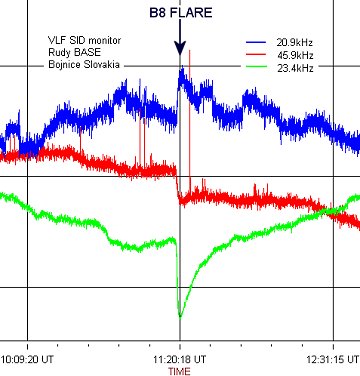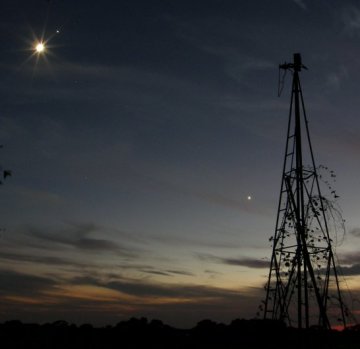| BEHOLD THE SUN: Would you like to see fiery prominences and new-cycle sunspots with your own eyes? On sale now: Personal Solar Telescopes. | | | MARS LANDER IN PERIL: The extreme cold and waning sunlight of martian winter are taking a severe toll on Phoenix. Information received over the weekend indicates the lander is running out of power each afternoon but reawakening after its solar arrays catch morning sunlight. Adding to Phoenix's troubles, a dust storm is dimming what little sun the lander has left. "We are trying to gain some additional science during however many days we have left," says Barry Goldstein of JPL. "Any day could be our last." [more] IONOSPHERIC DISTURBANCE: Magnetic fields above sunspot 1007 erupted yesterday, Nov. 3rd, sparking a B8-class solar flare. Although B-flares are considered minor, the blast nevertheless made itself felt on Earth. X-rays bathed the dayside of our planet and sent a wave of ionization rippling through the atmosphere over Europe. The sudden ionospheric disturbance (SID) disrupted propagation of VLF radio signals, a phenomenon recorded by Rudolf Slosiar of Bojnice, Slovakia: 
"Solar Cycle 24 is already showing up on my SID monitor," says Slosiar. "Detecting a minor B8 flare is a good test of the sensitivity of this method of monitoring solar activity." Sunspot 1007 is indeed an apparition of the next solar cycle; the spot's high latitude and magnetic polarity associate it firmly with Solar Cycle 24. Active new-cycle sunspots like "007" are going to become more common in the weeks and months ahead as the sun climbs out of solar minimum. Stay tuned. The SIDs are just getting started. sunspot photos: from Pete Lawrence of Selsey, West Sussex, UK; from M. Ugro et al. of South Portland, Maine; from Robert Arnold of Isle of Skye, Scotland; from Stephen Ames of Hodgenville, Kentucky; from Pavol Rapavy of Rimavska Sobota, Slovakia; from Paul Maxson of Surprise, Arizona; from Guenter Kleinschuster of Feldbach, Styria, Austria; THE GATHERING: Less than a month from now, on Dec. 1st, something extraordinary will happen in the night sky. Venus, Jupiter and the crescent Moon are going to converge on a single, tiny patch of the heavens only a few degrees wide. Such an eye-catching, traffic-stopping triple conjunction can only be described as the backyard astronomy event of the year. Last night in Weatherford, Texas, photographer Shannon L. Story got a 66% sneak preview when two-thirds of the trio got together, upper left: 
Jupiter and the Moon were in conjunction while Venus looked on from below. "It was a pretty show," says Story, but not as pretty as it's going to be. Mark your calendar for Dec. 1st and try to imagine the gathering to come. more images: from Eszter Farkas of Szeged, Hungary; from Becky Ramotowski of Tijeras, New Mexico; from Doug Zubenel of De Soto, Kansas; from Tom King of Watauga, Texas; from Richard Bell of Kalamazoo, MI; from Robert Rosenberg of Adony, Hungary; from Emanuele Colognato of Coral Gables, Florida; from Tamas Ladanyi of Budapest, Hungary;
Oct. 2008 Aurora Gallery
[Previous Octobers: 2007, 2006, 2004, 2003, 2002, 2001, 2000] | 
